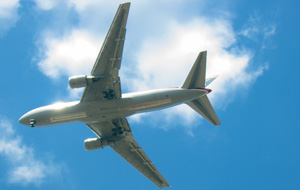Hot Trends and Cool New Destinations for 2020
The Yellow Railroad New Year 'Big Blog'

"Prediction is very difficult, especially if it's about the future."
(Niels Bohr, Nobel Prize winning physicist)
The luxury of prediction is irresponsibility. The Damaclean sword of accountability hangs far in the future; and reading the runes has always been viewed as guesswork rather than science. While future forecasting is, to a degree, based on observing past behaviour and technological developments, it would be a dull take on trends that merely extrapolated a straight line from past activity to future behaviour.
Some blue sky thinking has to be involved. Otherwise we'd all still be riding faster, fitter horses instead of driving cars, and travelling with 2 kilos of camera kit strung around our necks rather than relying on our phones.
The prospect of getting it far wrong has to be countenanced. Even on the cusp of the mobile phone boom in 2007, a Bloomberg article boldly stated “the i-Phone is nothing more than a luxury bauble that will appeal to a few gadget freaks." So, loosening the leash of accountability and casting off the ropes of past certainties are the starting point for thinking about the future.
Three of a Kind
In keeping with the irresponsible nature of prediction and space limitations, I have adopted the ‘rule of threes’ in looking at possible changes in 2020:
- Three main areas of change: megatrends, travel technology, and destinations.
- I explore 3-5 issues within each of these broad areas:
Megatrends: climate change; overtourism; geopolitical threats; natural disasters; and aviation;
Travel technology: artificial intelligence, voice recognition, and virtual reality;
Destinations: three rising stars, and two others appearing over the horizon.
This is merely an outline of some of the ‘big stuff’ I believe might affect travel in 2020, not a comprehensive or empirically-based analysis – an intellectual aperitif and thought-starter for the year. Nor is it about short-term issues, such as exchange rate fluctuations, which will increase or decrease tourism to various countries in the short-term. Rather it attempts to unearth the roots of longer-term trends, which will affect travel behaviour for years to come.
A. Megatrends

These are the three areas in which we are likely to see the greatest impact on travel in 2020.
1. Climate Change
 Greta Thunberg and the worldwide school pupil strikes appear to have been the catalyst between a general understanding of the need for behavioural change and a commitment to do something about it. So, what does this mean for travel?
Greta Thunberg and the worldwide school pupil strikes appear to have been the catalyst between a general understanding of the need for behavioural change and a commitment to do something about it. So, what does this mean for travel?
- Flygskam (‘flight-shaming’) entered the English vocabulary in 2019. For some, flying has assumed a socially irresponsible, detrimental and even sinful notoriety akin to smoking and drink-driving. There is evidence that some, albeit a minority starting with Scandinavians, are attempting to reduce their personal carbon footprint by travelling less, particularly by air. Substituting rail for air travel where possible, more ‘staycationing’, and fewer short breaks that involve air travel, are manifestations of an emerging trend. Maybe even sleeper trains will experience a resurgence, particularly across Europe. ‘Discretionary’ travel may start to fall out of fashion in certain circles and begin to be perceived as a bad habit, which unreconstructed globetrotters need to be weaned off. Travellers may not yet talk in hushed tones about where they’ve been; but people may increasingly feel the need to justify their trip – at least to themselves. Expect this to pick up a head of steam as the year progresses, but more in some countries than others.
- Environmental consciousness is likely to play a greater part in travellers’ choice of destination, tour operator and accommodation. Whereas there has been a gulf for many years between what people say they’ll do and what they actually do in relation to selecting environmentally responsible holidays and operators, its seems millennials are more likely to put their money where their conscience lies on this one. Expect tougher questions to be asked, particularly of holiday properties, about environmental impact, such as waste management, water consumption, local food sourcing et al.
- Corporate responsibility is likely to improve at a faster rate, with companies increasingly factoring climate impact into their management systems – from fewer offshore conferences and less non-essential business travel to supply chain reviews and local purchasing. But the big change may be in carbon offsetting by big players. Microsoft has just announced its intention to become carbon-negative, whereby it removes more carbon from the environment than it emits, by 2030. Easyjet has committed to offset carbon emissions from all fuel used in pursuit of its aim to be the world’s first net-zero carbon emissions airline, ahead of IAG, which has pledged to be carbon-neutral by 2050. While many consider carbon-offsetting to be little more than greenwashing, as it doesn’t reduce the carbon-emitting behaviour, it nevertheless channels funds into environmentally valuable projects. Easyjet has also signed a memorandum of understanding with Airbus to develop electric and hybrid planes. But this technology is likely to be some years off, let alone consumer confidence in battery-powered aircraft.
- ‘Bleisure’ – combining leisure and business trips – may grow, as people try to cut down the number of flights and add a leisure break to the end of their business trip. This hasn’t been a huge trend in recent years, in spite of the obvious cost-saving. But ‘flygskam’ might just push a few more people to try harder to make this work.
2. Overtourism
- ‘Overtourism’ has given tourism a bad rap in the last couple of years; and it will increase.
 While this is generally more about too many people in one place at one time, rather than a permanent condition with which a destination is afflicted, overtourism is adding to the tendency to demonise tourism. The main issues are a deleterious impact on the built and natural environment, dilution of the visitor experience, and strain on residents’ facilities and tolerance of visitors. Once a destination has a reputation for being overcrowded, even if it is only in August, it will often be perceived as experiencing this problem for a much longer period, even year-round, and, consequently, risks slipping down travellers’ holiday wish-lists.
While this is generally more about too many people in one place at one time, rather than a permanent condition with which a destination is afflicted, overtourism is adding to the tendency to demonise tourism. The main issues are a deleterious impact on the built and natural environment, dilution of the visitor experience, and strain on residents’ facilities and tolerance of visitors. Once a destination has a reputation for being overcrowded, even if it is only in August, it will often be perceived as experiencing this problem for a much longer period, even year-round, and, consequently, risks slipping down travellers’ holiday wish-lists.
- Mitigation measures are only slowly being applied, and sporadically around the world at that. Destinations that do have significant problems, whether only for a short period or longer, will increasingly introduce measures to reduce the impact, such as entry charges (e.g. Venice), quotas (cruises – e.g. Dubrovnik), advance booking/timed slots (e.g. Uffizi Gallery, Florence; Shard, London and many more) and ‘demarketing’, whereby tourism boards and destination management organisations actively embargo the promotion of certain destinations (e.g. Amsterdam). Tourism taxes, so long resisted by the British hospitality sector, will start to become the new normal. They are not really a way to reduce congestion, but more a revenue-raising tactic. Expect Edinburgh to lead the way as the first UK city to introduce a tourism tax, after legislation enabling local authorities to raise it is passed in the Scottish parliament.
- Short-term lets, epitomised by poster child Airbnb, which owns no real estate but is allegedly worth more than the world’s top five hotel companies combined, have come in for increasing criticism in many cities and countries. Where this has taken root, it has tended to distort the property market, pricing local people out of homes. When short-term lets to visitors have proven more profitable than long-term tenancies for residents, and complaints abound about communities being hollowed out as a result, the authorities have begun to react. Many cities around the world have imposed a limit of 90-120 days’ rental per year. But Palma de Mallorca has banned almost all short-term rentals on the island after property prices exploded by 40% between 2013-2018: Amsterdam has set a limit of 30 days p.a.; while New York has attempted to retain long-term rental capacity by making it illegal to rent out an entire apartment for less than 30 days. Expect to see many more, and much more draconian, measures to curb short-term holiday lets in 2020 worldwide, particularly in popular cities.
3. Geopolitical Threats and Natural Disasters
Political Turbulence and Government Inertia
- Regional instability will continue to dampen travel to some areas,
 while political-economic tremors will impact on others. Brexit, US-China trade war, natural disasters (bush fires in Australia, floods in Japan, hurricanes in the Caribbean, Asia and Africa) and the war in Syria have dominated the headlines in 2019, with some impact on travel. Although the legislation has passed, Brexit will continue to affect UK tourism, not least because of the hospitality industry’s reliance on foreign workers, who are far from meeting the UK government’s minimum entry requirement of a £30,000 salary. Expect some movement on this, but not enough fast enough. The government says it is listening to the industry and is prepared to make exceptions, where it is ‘in the national interest’. But there’s a huge gulf between listening and action. Even if it wanted to, it seems implausible that the necessary debate could be held and legislation passed in time to enable enough foreign workers earning below this regulatory minimum to be recruited for the 2021 season.
while political-economic tremors will impact on others. Brexit, US-China trade war, natural disasters (bush fires in Australia, floods in Japan, hurricanes in the Caribbean, Asia and Africa) and the war in Syria have dominated the headlines in 2019, with some impact on travel. Although the legislation has passed, Brexit will continue to affect UK tourism, not least because of the hospitality industry’s reliance on foreign workers, who are far from meeting the UK government’s minimum entry requirement of a £30,000 salary. Expect some movement on this, but not enough fast enough. The government says it is listening to the industry and is prepared to make exceptions, where it is ‘in the national interest’. But there’s a huge gulf between listening and action. Even if it wanted to, it seems implausible that the necessary debate could be held and legislation passed in time to enable enough foreign workers earning below this regulatory minimum to be recruited for the 2021 season.
Beyond the Middle East
- Indications are that, after the US assassination of Qasem Soleimani in Iraq and Iranian retaliation, which took down Ukraine Airlines flight 752, in January, the Middle East will become less stable. This will not only reduce travel to previously emerging destinations in the Middle East, with one or two exceptions (see Destinations below); but it will also add cost to east-west long-haul flights between Europe, Asia and beyond, as airlines will have to detour around the region, not just Syrian airspace, potentially making travel to and from Asia, Australia and New Zealand more expensive. There is a risk of a power vacuum in Iraq, if US troops are obliged to leave, which will, in part be filled by Iran. Coupled with the US withdrawal from Kurdish northern Syria and Turkey’s consequent invasion of the area, these events may enable a resurgence of Daesh/ISIS, giving them greater capacity to mount sporadic terrorist attacks in a number of countries well beyond the region, whose tourism would immediately suffer.
It’s Not All Greek to Some
- Minor military scuffles in the Aegean and suggestions by Turkish president Erdogan for redrawing the Greece-Turkey maritime border have caused fears in Greece that he may have his eye on some of the islands in the eastern Aegean close to the Turkish coast. Any escalation could jeopardise all Greek island tourism, even as far away as the Ionian, as geographical awareness tends to be trumped by the pursuit of hedonism for many Mediterranean island holidaymakers. Hopefully no oil will be found in the region and NATO will be able to hold the coats of its two scrapping members.
No-Go Areas and Remarkable Recoveries
- There is little sign of a resolution of the issues that led to the protests in Hong Kong, which have had a significant impact on its tourism. The beautiful region of Kashmir has long been a largely no-go area for tourism. The Indian government’s new citizenship law, widely perceived as anti-Muslim, will do nothing to bring it back into the fold any time soon. It may also spill over into travel restrictions or disincentives to travel in northern India. Otherwise, there is likely to be no change in the world’s long-embedded conflict zones and places perceived as high risk for travellers, such as Palestine, Israel, Pakistan, Mali, Yemen, Iraq and Afghanistan; and Iran, whose tourism was beginning to pick up, has now re-joined that cohort. Egypt, Turkey, and Tunisia on the other hand, all of whom experienced significant drops in tourism after terrorism incidents in recent years, have bounced back remarkably.
4. Aviation
- No-frills airlines will continue to thrive, but primarily only on short-haul routes.
 They are also likely to grow, sometimes under the wing of legacy carriers, as evidenced by Cathay Pacific’s buying Hong Kong Express last year. In spite of attempts at providing low-cost long-haul services, most have struggled, either failing or only just surviving (Wow, Air Asia, Norwegian). 2020 is unlikely to see progress for the low-cost long-haul dream.
They are also likely to grow, sometimes under the wing of legacy carriers, as evidenced by Cathay Pacific’s buying Hong Kong Express last year. In spite of attempts at providing low-cost long-haul services, most have struggled, either failing or only just surviving (Wow, Air Asia, Norwegian). 2020 is unlikely to see progress for the low-cost long-haul dream.
- Airfares are likely to rise in 2020. This will be a mix of the $US dollar strength (in which payments must be made for fuel and many airlines borrow in dollars); the prospect of one of the world’s most cost-efficient planes and beloved workhorse of so many airlines, the Boeing 737 Max, remaining grounded well into 2020 and the consequent squeeze on short-medium-haul capacity; and international tensions leading to extra costs for insurance and detours around dangerous airspace.
- Air Passenger Duty in the UK has entered the spotlight, with the surprising government ‘bail-out’ of Flybe, which seems to fly in the face of the government’s own stated commitment to addressing climate change. Will this prompt a review, and possible removal, of domestic APD, as the government squirms to persuade transport operators that what is sauce for the Flybe goose must also be sauce for the entire transport network gander?
B. Travel Technology

Artificial intelligence (AI) is the new frontier for technological innovation. Scary for some, convenient and efficient for others, I suspect we have no idea how revolutionary it will prove in a few years’ time. The use of big data to anticipate and serve our needs is only the start.
- Voice recognition will, I suspect, be the biggest leap forward in terms of the application of AI to travel next year. Alexa, Siri, Amazon Echo et al will soon feel as clunky as two-way radios compared to smartphones. Bypassing buttons and finger swipes, voice activation will offer much quicker and more refined access to information, book travel and communicate with others, whether on social media or directly. 50% of US teenagers use voice search every day and voice-based shopping is expected to jump to $40 billion in 2022. And, if you still think this sounds more science fiction than future fact, consider that Amazon has over 10,000 employees working on Alexa…………..That’s a lot of recipe requests!
- Face recognition will also come into its own in 2020 as a means of identity check. Airports will increasingly use it, not just at border control, but also for check-in and boarding. The time saving is potentially transformative: an OAG study found 50% of travellers waited at least 45 minutes in airport queues. Contrast that with Emirates’ plans in 2020 for US-bound passengers from Dubai, whose identity will be checked in two seconds or less at departure gates by face recognition.
- Virtual reality will transform the process of planning travel. But it will not supplant the experience itself, as some have predicted. As costs come down and the technology improves, expect to see VR become much more widely used – to explore a destination, inspect hotel rooms and facilities, take a virtual tour, and devise personal itineraries and experiences, all linked by voice recognition, with links to booking systems – particularly from Instagram and other social media, primarily via mobile phones and, perhaps increasingly, wearables.
C. Destinations

Last year saw relatively untravelled destinations spring into adventurous travellers’ sights, such as Georgia and Patagonia. The main driver behind the emergence of new destinations is a search for somewhere different, which hasn’t yet hit the screens of mainstream tourism operators’ programmes, and where there is still a degree of unspoilt nature and cultural authenticity to explore. With the global boom in tourism and recognition of its revenue potential by destinations worldwide, such places are now very few and far between. Three destinations I would expect to burst into travellers’ consciousness in 2020 are:
- Saudi Arabia: Rich in cultural heritage sites, pristine nature and virgin coastlines, Saudi Arabia is still relatively unexplored because foreign visitors have not been encouraged. But the kingdom has recently recognised a need to reduce its dependence on oil and diversify its economy, by developing tourism. This volte-face saw the introduction of tourist visas for 49 countries late last year. The pristine nature of so much of the land and sea offers an opportunity for developing the best form of environmentally sensitive tourism – for luxury escapes, hiking and scuba diving in particular. The Red Sea Project is one high profile initiative aiming to do so, in an area covering an archipelago of 90 islands, desert, volcanos, and canyons. Expect to see a limited number of ultra-luxury developments, which demonstrate state-of-the-art environmentally sensitive practice, emerge down the Red Sea coast.
- Albania: Last European nation to leave the communist fold, and one of the harshest and most impenetrable, Albania has taken its time to embrace tourism. But its efforts of the last few years are beginning to pay off. Its beaches face Corfu; the capital, Tirana, has acquired a reputation for its nightlife; its Balkan heritage, ancient Greek and Roman remains, and years of secretive communist rule endow it with historical intrigue; and its mountains are stunning. I should know; I hiked over ‘the Accursed Mountains’ from Montenegro into Albania several years ago and this route is now featured in several walking tour companies’ programmes. Hotel accommodation, although variable, is improving, but rural accommodation for hikers brings visitors closer to the real Albania. Still primarily an adventure travellers’ destination, described by one hiking tour operator as "one of the last great off-the-beaten-track places to be found for walking and trekking in Europe", Albania will become possibly the last ‘undiscovered’ destination in Europe to be discovered
- Uzbekistan: Probably lumped together historically with other far-off ‘stans’ and dismissed as a rural Soviet backwater too far off the beaten track to be of interest, Uzbekistan has lain largely below western travellers’ radar. But, as people seek new, relatively undiscovered, culturally fascinating destinations, Uzbekistan will stick its hand up big time. With the Silk Road running through the country like DNA, the cities of Samarkand, Bukhara and Khiva dazzle with some of the Muslim world’s most stunning architecture. This is travel on an epic, Byronic scale, visually breathtaking, culturally and historically dramatic. Expect to see Uzbekistan pop up in many more tour operators’ programmes as one of the fastest growing ‘cool’ new destinations in 2020.
Breaking the ‘rule of threes’, there are two other destinations that deserve a mention as likely to experience a growth spurt in 2020:
- Colombia: The cocaine trade may still be booming, but with the FARC rebel peace deal now almost three years old, Colombia has an opportunity to grow its tourism from further afield. It offers a mix of culture, history, nature, wildlife, beaches, flavoured with a tinge of the exotic, which has every chance of grabbing the attention of European travellers, whose interest in Latin America has, understandably because of geography, lagged far behind that of North Americans.
- Kyrgyzstan: Still largely unexplored by western visitors, quite rudimentary and very much an adventure travel destination, expect Kyrgyzstan to be the ‘new Georgia’, in 2020. Like Uzbekistan, it has long lain below the radar of tour operators and languished as one of the band of undifferentiated ‘stans’ in western traveller’s eyes. But its stunning mountains are likely to start attracting hikers and propel it into the pages of adventure tour operators’ programmes as the latest, undiscovered hiking destination – possibly the most exotic new kid on the block for adventure tour operators in 2020. Having visited Kyrgyzstan will be the equivalent of a triple word score in Scrabble around the dinner tables of the travel cognoscenti next year.
Conclusion: Putting Change in Perspective

Steady as They Go
Tourism is a remarkably resilient sector. Growth appears to be inexorable worldwide. As we’ve seen with destinations such as Egypt, Tunisia and Turkey, the propensity to bounce back, even after major terrorism incidents, is considerable. So, few destinations are likely to experience significant decline in 2020, apart from those in the throes of turmoil such as Hong Kong, or where economic circumstances turn against them or crises hit.
Rising Stars
Where we are likely to see disproportionate growth is in the formerly shy retiring destinations: lesser known places in established destinations. Growth rates to secondary destinations, will outstrip that to honeypots. Puglia will outpace Tuscany; Seville will grow faster than Barcelona; and rural areas throughout Europe will come into their own. This bodes well for remoter areas that other economic activity has failed to reach.
Stop Trampling on My Daisies…...and My Way of Life
Perhaps the biggest unknown remains whether destinations, and particularly destination management organisations (DMOs) and governments, can wean themselves off their addiction to numbers, which are destroying the destination, the visitor experience, and the local way of life for at least a few months of the year in many places. That said, many of these same destinations desperately need visitors outside the main season to remain viable. This balance needs to be redressed to ensure tourism contributes positively and sustainably to local community life, with minimal negative impacts. This will take a shift in mindset from destination marketing to destination management. It will require politicians to forego media soundbites trumpeting growth and summon the resolve to instruct destination management organisations to pursue quality, rather than quantity, and develop the kind of tourism that demonstrably benefits the destination. It will also require a whole new skill set in many DMOs. But it won’t earn half as much publicity for politicians as a “10% growth” headline. Therein lies the rub. Will they have the courage to do the right thing? Will residents’ pressure make this situation impossible to ignore? Or will complacency and self-interest continue to trump action? Only time – and negative media headlines – will tell.
Stability Is the Bedrock of Change
Critically, when all around are losing theirs, the tourism industry needs to keep its head, and recognise the nature of change. Dramatic innovation in technology, customer service, communications and booking channels, have certainly shifted the balance of power more in favour of the customer than ever before. But, in spite of the changes in behaviour this has enabled – from cheaper travel, impulse-purchasing, and widespread peer-to-peer reviews – what we must remember is that human desires, as expressed in travel motivation and the appetite to see somewhere different, remain relatively constant. It’s primarily the means of accessing information, booking, and entertainment, which serve these human needs, that have been transformed, not the needs and desires themselves. People still want fun, relaxation, cultural immersion, adventure, entertainment and inspiration. It’s just how these are delivered that has changed. And if we lose sight of this, we lose our reason. Gertrude Stein put it best: “Everybody gets so much information all day long that they lose their common sense”………..And that was long before the internet era!
Climate Change Culpability in Perspective
A final word on climate change – not to absolve the tourism sector from taking action, but to put the problem in perspective: while aviation is estimated to account for around 2% of global carbon emissions, internet usage apparently accounts for twice that, at 4%. But the fashion industry accounts for around 10%, is allegedly the world’s second largest consumer of water, and a significant contributor of micro-plastic waste in oceans. So, before demonising air travel, maybe we should at least consider wearing out a few old shirts, or resist the urge to stream Netflix via our mobile phones throughout the entire journey on those trains we’re all going to be using so much more........Bon voyage!

